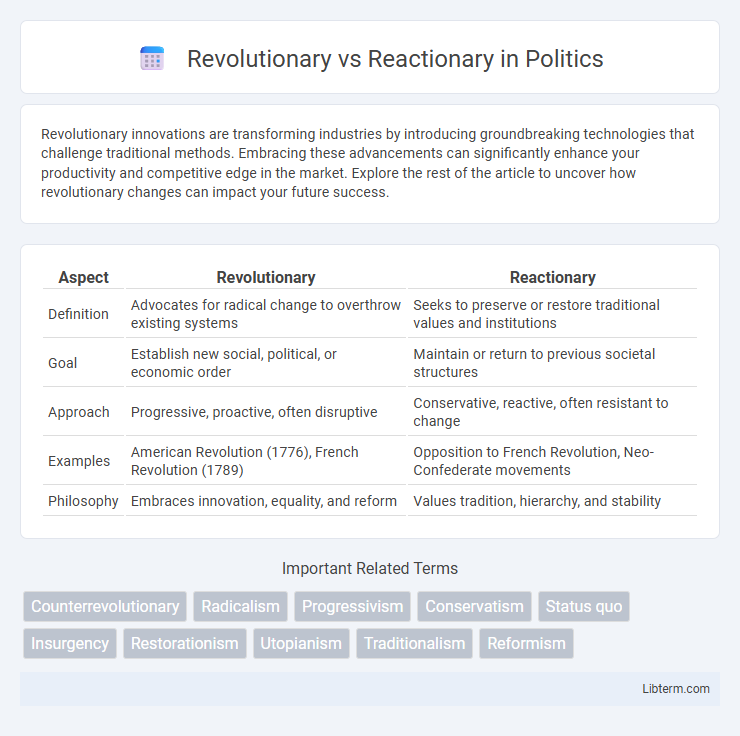Revolutionary innovations are transforming industries by introducing groundbreaking technologies that challenge traditional methods. Embracing these advancements can significantly enhance your productivity and competitive edge in the market. Explore the rest of the article to uncover how revolutionary changes can impact your future success.
Table of Comparison
| Aspect | Revolutionary | Reactionary |
|---|---|---|
| Definition | Advocates for radical change to overthrow existing systems | Seeks to preserve or restore traditional values and institutions |
| Goal | Establish new social, political, or economic order | Maintain or return to previous societal structures |
| Approach | Progressive, proactive, often disruptive | Conservative, reactive, often resistant to change |
| Examples | American Revolution (1776), French Revolution (1789) | Opposition to French Revolution, Neo-Confederate movements |
| Philosophy | Embraces innovation, equality, and reform | Values tradition, hierarchy, and stability |
Defining Revolutionary and Reactionary: Key Concepts
Revolutionary refers to individuals or movements advocating for radical, transformative change aimed at fundamentally altering existing social, political, or economic systems. Reactionary denotes those who seek to preserve or restore traditional structures, often opposing progressive reforms and favoring a return to a prior state. Key concepts defining revolutionary involve innovation, upheaval, and future-oriented goals, while reactionary emphasizes conservatism, restoration, and resistance to change.
Historical Contexts: Origins of Revolutionary and Reactionary Thought
Revolutionary thought emerged during periods of profound social and political upheaval, such as the Enlightenment and the French Revolution, emphasizing radical change and the overthrow of existing power structures. Reactionary thought developed as a conservative response aimed at preserving traditional institutions and hierarchies threatened by revolutionary movements, with notable examples in post-Napoleonic Europe and 19th-century monarchist resurgence. Both ideologies reflect contrasting historical reactions to modernization and social transformation, shaping political discourse in diverse eras and cultures.
Ideological Foundations: What Drives Revolutionaries and Reactionaries?
Revolutionaries are driven by ideals of radical change and social justice, often rooted in theories of equality, progress, and liberation, seeking to dismantle existing power structures perceived as unjust. Reactionaries prioritize the preservation or restoration of traditional social orders and values, motivated by a belief in stability, hierarchy, and cultural continuity. These ideological foundations shape their approaches to political and social transformation, with revolutionaries advocating for innovation and reactionaries emphasizing conservation.
Political Movements: Famous Revolutionary and Reactionary Examples
Revolutionary political movements such as the Bolshevik Revolution in 1917 China's Communist Revolution radically transformed societal structures by overthrowing existing regimes to establish new ideological orders. Reactionary movements like the French royalist counter-revolution aimed to restore traditional monarchies and social hierarchies, resisting progressive changes and democratic reforms. Both types of movements significantly shaped modern political landscapes by either challenging the status quo or seeking to reinstate previous political conditions.
Methods and Strategies: How Each Side Seeks Change
Revolutionaries pursue rapid, often radical transformation through mass mobilization, direct action, and sometimes force to overthrow existing systems perceived as unjust. Reactionaries rely on preserving or restoring traditional social orders using conservative political tactics, institutional power, and incremental reforms to resist or reverse progressive changes. Each side's methods reflect their core goals: revolutionaries aim for systemic overhaul, while reactionaries focus on stability and continuity.
Social Impact: Effects on Society and Culture
Revolutionary movements drive profound social transformation by challenging established institutions and promoting progressive ideologies that reshape cultural norms and values. Reactionary forces seek to restore traditional social orders, often resisting change to preserve existing hierarchies and cultural heritage. The tension between revolutionary change and reactionary preservation shapes societal evolution, influencing social cohesion, identity, and collective values over time.
Revolutionary vs Reactionary: Comparison of Goals and Outcomes
Revolutionaries seek radical change to overthrow existing systems, aiming for transformative social, political, or economic reforms, while reactionaries strive to restore previous conditions or resist progress, favoring traditional structures. Revolutionary outcomes often include systemic shifts and the creation of new institutions, whereas reactionary efforts typically reinforce existing power dynamics or revert societies to earlier states. The comparison highlights the contrasting orientations toward change, where revolution promotes innovation and upheaval, and reaction emphasizes preservation and retrenchment.
Modern Manifestations: Contemporary Revolutionary and Reactionary Movements
Contemporary revolutionary movements often harness digital platforms to mobilize support, advocating for systemic changes in areas such as climate justice, racial equality, and economic redistribution. Reactionary movements tend to emphasize the preservation or restoration of traditional social orders, using social media to disseminate nationalist, anti-globalization, or conservative ideologies. Both movements significantly influence political landscapes, shaping policy debates and public opinion in diverse democratic societies worldwide.
Criticisms and Controversies: Debates Surrounding Both Approaches
Revolutionary approaches face criticism for provoking social upheaval that can lead to instability and loss of life, while reactionary stances are often condemned for resisting necessary progress and perpetuating outdated power structures. Debates focus on the ethical implications of drastic change versus preservation of tradition, highlighting controversies over the legitimacy and consequences of both methods. Intellectual discourses challenge whether revolutionary fervor justifies disruption or if reactionary caution hinders societal evolution.
The Future of Revolutionary vs Reactionary Dynamics
Revolutionary dynamics often drive transformative societal change by challenging established structures, while reactionary forces seek to preserve traditional values and resist rapid shifts. The future of these opposing dynamics depends on technological advancements, social movements, and political landscapes that shape how swiftly or rigidly societies adapt. Understanding the interplay between revolutionary innovation and reactionary stability is crucial for predicting patterns of governance and cultural evolution.
Revolutionary Infographic

 libterm.com
libterm.com